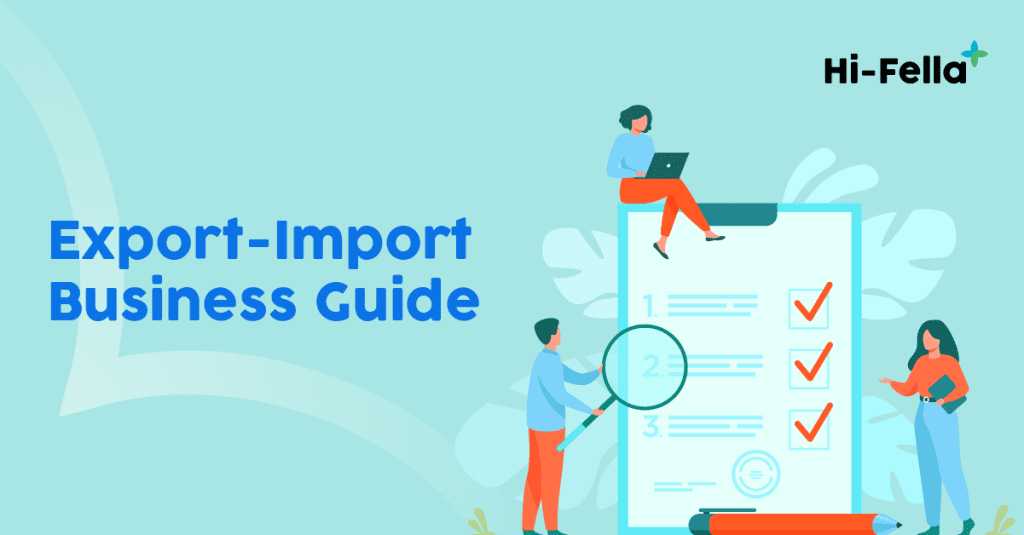Starting an export-import business is like setting off on a worldwide journey of business opportunities, especially as a businessman who just got into the world of export-import. This article will provide you your ultimate guide to launching and succeeding in the import-export business world. Learn from experts and avoid common pitfalls to navigate the intricate landscape of export-import trade.
Step-by-step guide to start an import and export business
Starting an import and export business could be such a hassle at first. But don’t worry, these step-by-step import export business guides would help you.
- Choose the product you want to import or export
Two questions you can ask yourself on deciding which products to import or export are: can I sell this commodity and am I passionate about this commodity? Research about your desired commodity first. Is it suitable for you or not? Can you do it or not? - Register your business
Make your business official by registering it. You can research the regulation of import-export business in your region. After that you need to register with the local, state, or national government. Depending on the rule, you may also need to propose for foreign qualification and obtain proper licences. - Grow your online presence
Create websites, social media accounts, and add contact information to your online presence. This will give you a chance to be recognized. That way you can easily open up for communications, market your products, grow customers, and deliver wonderful customer service. - Source your products
Find a reputable and suitable supplier for your import-export business. This could mean a local manufacturer or even international supplier. Research first about the suppliers you want to collaborate with. Can they provide for your products? Do they have a certain amount of ordering? How do they produce their products? These should be considered when choosing for suppliers. - Obtain a customs bond
As an import-export business, you have to obtain a customs bond. It’s like insurance for the taxes and fees you need to pay when you bring goods into a country. You usually need this if your shipments are worth $2,500 or more. It helps things go smoothly when you’re trading between countries. If you’re running a business, you’ll likely get a customs bond that lasts for a year and covers all your shipments during that time. - Plan for the logistic and distribution
Figure out how to move your products. Is it by sea, land, or air? Figure out how to package your product for distribution. Some products need secure and strong packaging in order to last in the delivery while others might not need that. Additionally, you need to decide how to store your product and organize first- and last-mile transport. - Market your business
This is one of the most important steps for your business. Market your products or services. Depending on your products or service, this could be cold-calling customers to making an elaborative marketing campaign. Whatever method you choose, you need to have a strong identity for your business, have prices that are attractive compared to others in the market, and be visible on the internet. Know who your customers are and what they need, then tailor your offerings to meet those needs.
Finding reliable suppliers for import and export
Finding suppliers could be tricky. Sometimes there are suppliers that are not trusted enough or that are not suitable for your business. However, this is one of the important import export business guides. Here are the requirements for a good and reliable supplier for you to consider.
- A good fit
Before deciding on a supplier, you have to make sure that the supplier is a good fit for you based on these criterias: having an excellent product information, excellent packaging, quality, convenience, and price, having a good company environment that put friendliness and creativeness forward, and have a good relationship with the key contact. - Supplier can keep up with the demand
After listing potential suppliers, make sure that the supplier can keep up with their customer demand. You can ask them directly if they’re able to provide a certain amount or a certain request for a product for your business. You can also research or ask for their production capability and product availability, whether they are able to produce a certain amount of product or if their product is available at the moment. You have to research how they advertise, their websites and social media. If they have an active media presence and have a good exposure to the world, it can be deduced that the supplier can keep up with their customer’s demands. - International marketing strategies for import/export business
In order for your business to be recognized, you have to market it. This is also one of the import export business guides. There are several ways for you to try to market your business. - Know your business well
Before promoting your business, you have to know the ins and outs of your business well. Knowing the strengths, weaknesses, what you can do, and what you cannot do will help you to determine your next move regarding marketing your business. - Set goals
Setting goals in business, especially in import-export business, is a smart move. Set the goal from the littlest, then slowly move up to the bigger goals. Getting your business recognized could be a better goal to start with, then you can move up to get a buyer for your business. - Research
Research who’s your competitor, what they do and what you can do to achieve that. You also have to understand your target market, the behaviour of your clients, cultures, locations, and people around them. Research for the price you have to spend on marketing and make sure to not spend that much money on marketing campaigns. The result of this research will determine your next move. - Participate in import-export trade fairs
Participating in import-export trade fairs is one of the most effective ways to market your import-export business. Trade fairs can attract people to know about your business, possibly attract potential consumers and suppliers too. You can exchange contacts with other businessmen and possibly have collaboration with them too in the future. - Work properly
After you know the strategies to market your import-export business, you have to work accordingly to your goals and plans. Don’t gamble on your business for this is one of the crucial steps of your business. You have to prepare everything properly so that your business can run smoothly.
Ready to take your export-import ventures to the next level? Join the global trade community at Hi-Fella, an online platform where suppliers and buyers from around the world meet. Download Hi-Fella app on Play Store or App Store and sign up for an account, you can carry out export-import at Hi-Fella. Come and join us now!






